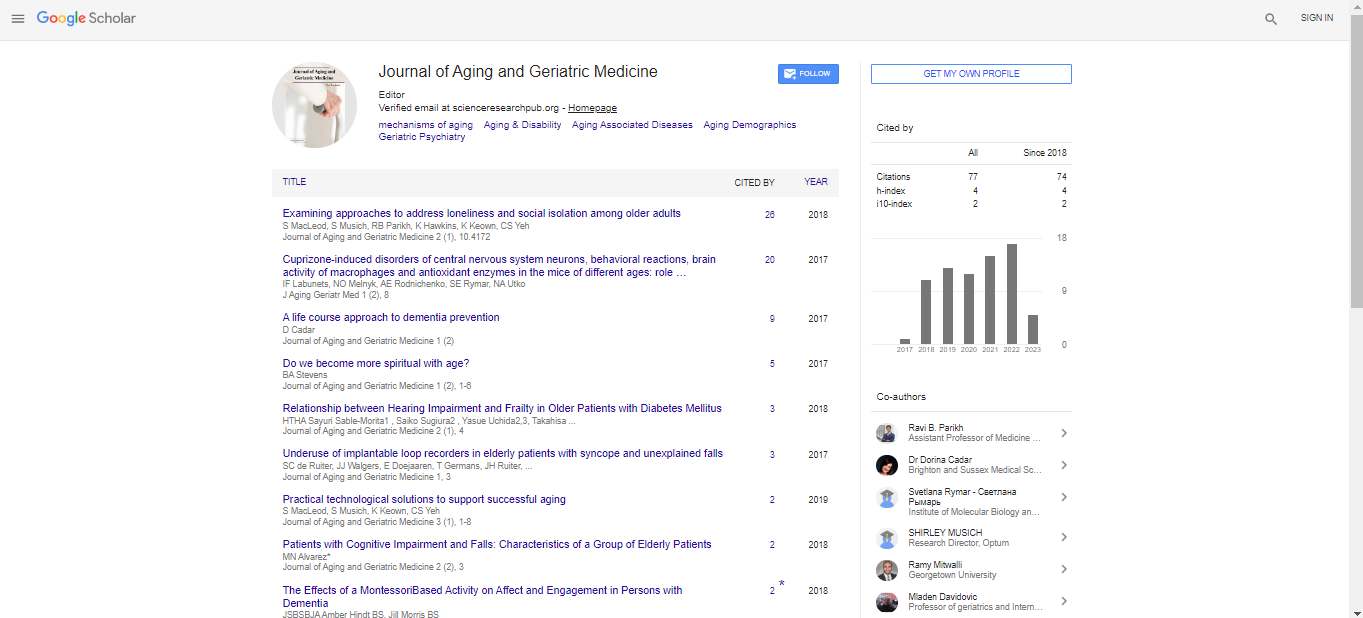Perspective, J Aging Geriatr Med Vol: 6 Issue: 3
Development of Alzheimers Disease: A Narrative Review
Yannick Vermeiren*
Department of Human Nutrition and Health, Wageningen University & Research (WUR), Wageningen, Netherlands
*Corresponding author: Yannick Vermeiren, Department of Human Nutrition and Health, Wageningen University & Research (WUR), Wageningen, Netherlands,
E-mail: yannick.vermeiren@wur.nl
Received date: 03 March, 2022, Manuscript No. AGM-22-60784;
Editor assigned date: 05 March, 2022, PreQC No. AGM-22-60784 (PQ);
Reviewed date: 19 March, 2022, QC No AGM-22-60784;
Revised date: 24 March, 2022, Manuscript No. AGM-22-60784 (R);
Published date: 31 March, 2022, DOI: 10.4172/ ISSN: 2576-3946.1000134.
Citation: Vermeiren Y (2022) Development of Alzheimer’s Disease: A Narrative Review. J Aging Geriatr Med 6:3.
Keywords: Alzheimer Disease
Description
Alzheimer’s complaint ( Announcement) is the most common cause of madness, counting for further than 50 million cases worldwide. Current substantiation suggests the exact medium behind this ruinous complaint to be of multifactorial origin, which seriously complicates the hunt for an effective complaint- modifying remedy, as well as impedes the hunt for strategic precautionary measures. Of interest, preclinical studies point to serotonergic differences, either convinced via picky serotonin reuptake impediments or serotonin receptor (ant) agonists, in mollifying Announcement brain neuropathology next to its clinical symptoms, the ultimate being supported by a sprinkle of mortal intervention trials. Also, a substantial quantum of preclinical trials punctuate the eventuality of diet, fecal microbiota transplantations, as well as pre-and probiotics in modulating the brain’s serotonergic neurotransmitter system, starting from the gut. Whether similar interventions could truly help, reverse or decelerate down Announcement progression likewise, should be originally tested in preclinical studies with Announcement mouse models, including sufficient logical measures both in gut and brain. Later, its implicit remedial effect could be verified in strictly randomized controlled trials in humans, preferentially across the Alzheimer’s continuum, but especially from the prodromal up to the mild stages, where both high adherence to similar curatives, as well as sufficient room for conspicuous improvement are doable still. In the end, similar studies might prop in the development of a comprehensive approach to attack this complex multifactorial complaint, since serotonin and its derivations across the microbiota- gut- brain axis might serve as possible biomarkers of complaint progression, coming to forming a precious target in Announcement medicine development. In this narrative review, the available substantiation concerning the orchestrating part of serotonin within the microbiota- gut- brain axis in the development of Announcement is epitomized and bandied, and general considerations for unborn studies are stressed.
Serotonergic Neurotransmitter System
Madness roughly affects 50 million people worldwide, and figures are anticipated close to double every 20 times (Prince etal., 2015). Madness is a broader term for the decline in cognitive function, including memory, literacy and thinking, in a more drastic manner than is anticipated from normal aging (WHO, 2020). This can be caused by a range of conditions, yet, the most common bone is Alzheimer’s complaint ( Announcement) which accounts for 60 – 70 of all cases as stated by the WHO. Although Announcement is considered a complaint of the senior, Zhu etal. (2015) estimated that early- onset Announcement (< 65 times) accounts for 6 of cases. Anyhow of the age of onset, the course of the complaint extends over a period of about 15 – 25 times as a continuum (Scheltens etal., 2021). At onset of the pathology, the case may be asymptomatic or experience mild cognitive impairment (MCI). Over time, still, symptoms gradationally come worse in function of the progressive neuronal loss (Duyckaerts etal., 2009; Förstl and Kurz, 1999). During all complaint stages, a change in mood and geste is frequently educated (Lyketsos etal., 2002). These common neuropsychiatric symptoms include anxiety, depression, perversity, reduced appetite, hackneyed geste, psychosis and aggression (Craig etal., 2005). Given the cognitive and behavioral differences, the madness pattern forms a burden both on the individual suffering from the complaint, as well as on family, caregivers, musketeers in addition to the entire society. As an suggestion, the global socioeconomic costs for madness were calculated to be about 670 billion euros in 2015 (Prince etal., 2015).
Although numerous gene polymorphisms have been linked to Announcement, genetics give a far from complete explanation, with an exception for the rare domestic ( frequently early- onset) forms of Announcement (Gatz etal., 2006, Vogrinc etal., 2021). Nonetheless, related genes may give an suggestion of the possible pathophysiological mechanisms, similar as with the apolipoprotein-E (APOE) determined allelic threat variation (Scheltens etal., 2021). The general picture of Announcement consists of the progressive topographic decline in cholinergic, catecholaminergic (dopamine, (nor) adrenalin) and indoleaminergic (serotonergic) neuronal functioning and loss (for review ŠimiÄ? etal., 2017), anteceded by neurotoxic amyloid-beta (Aβ) shrine aggregation extraneuronally, and, intraneuronally deposited neurofibrillary befuddlements (NFT) of phosphorylated tau (P-tau), both being histological emblems of Announcement (Braak and Braak, 1991). Other factors are suspected to be inversely involved, similar as a blood- brain hedge disintegrity, oxidative stress and mitochondrial dysfunction (Vidal and Zhang, 2021). Another etiological factor is the glycosylation of lipids and proteins, giving rise to advanced glycation end products (Haukedal and Freude, 2021). Likewise, a substantial quantum of substantiation suggests that neuroinflammation plays a contributing part in Announcement development by accelerating the abovementioned processes (Kinney etal., 2018). Especially microglia feel to be involved (Hansen etal., 2017). Eventually, the microbiota- gut- brain axis may be involved in the development of Announcement as well (Bonfili etal., 2021, Doifode etal., 2021I, Generoso etal., 2020, Kesika etal., 2021). All by each, these suspected complaint modulators are current targets in the ongoing hunt for an effective cure (Cummings etal., 2021). At the same time, Livingston etal. (2020) linked 12 potentially adjustable threat factors across the lifetime, counting for around 40 of worldwide mania, abetting the development of public health forestallment strategies. Of these threat factors, life in general plays a prominent part.
 Spanish
Spanish  Chinese
Chinese  Russian
Russian  German
German  French
French  Japanese
Japanese  Portuguese
Portuguese  Hindi
Hindi 